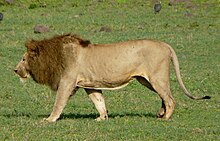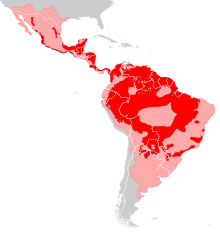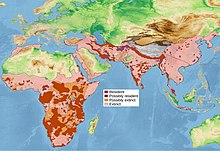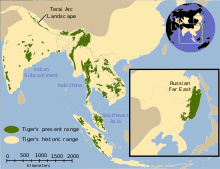สกุลแพนเทอรา
| สกุลแพนเทอรา[1] ช่วงเวลาที่มีชีวิตอยู่: สมัยไมโอซีนตอนปลาย – ปัจจุบัน, 5.95–0Ma | |
|---|---|

| |
| จากบนลงล่าง: เสือโคร่ง, สิงโต, เสือจากัวร์, เสือดาว, เสือดาวหิมะ | |
| การจำแนกชั้นทางวิทยาศาสตร์ | |
| โดเมน: | ยูแคริโอต Eukaryota |
| อาณาจักร: | สัตว์ Animalia |
| ไฟลัม: | สัตว์มีแกนสันหลัง Chordata |
| ชั้น: | สัตว์เลี้ยงลูกด้วยนม Mammalia |
| อันดับ: | สัตว์กินเนื้อ Carnivora |
| อันดับย่อย: | เฟลิฟอเมีย Feliformia |
| วงศ์: | เสือและแมว Felidae |
| วงศ์ย่อย: | วงศ์ย่อยเสือใหญ่ Pantherinae |
| สกุล: | สกุลแพนเทอรา Panthera Oken, 1816 |
| ชนิดต้นแบบ | |
| Panthera pardus[2] Linnaeus, 1758 | |
| ชนิด | |
| ชื่อพ้อง | |
| |
สกุลแพนเทอรา หรือ สกุลเสือ (ชื่อวิทยาศาสตร์: Panthera) เป็นสกุลในวงศ์ Felidae ที่ได้รับการตั้งชื่อและอธิบายโดย Lorenz Oken ใน ค.ศ. 1816 ซึ่งรวมแมวลายจุดทั้งหมดเข้าในกลุ่มนี้[5][2] เรจินัลด์ อินเนส โพค็อกปรับปรุงการจัดอันดับสกุลนี้ใหม่ใน ค.ศ. 1916 โดยจัดให้เสือโคร่ง (P. tigris), สิงโต (P. leo), เสือจากัวร์ (P. onca) และเสือดาว (P. pardus) อยู่ในกลุ่มนี้จากลักษณะกะโหลกศีรษะเหมือนกัน[6] ผลจากการวิเคราะห์ทางพันธุกรรมระบุว่าเสือดาวหิมะ (อดีต Uncia uncia) อยู่ในสกุล Panthera (P. uncia) ซึ่งเป็นการจัดอันดับที่ทางผู้ประเมินบัญชีแดงไอยูซีเอ็นยอมรับใน ค.ศ. 2008[7][8]
เสือในสกุลแพทเทอรา ทั้ง 4 ชนิดมีโครงสร้างทางกายวิภาคที่ช่วยให้พวกมันสามารถคำรามได้ เริ่มแรกมีสมมุติฐานว่าเกิดจากการกลายเป็นกระดูกที่ไม่สมบูรณ์ของกระดูกไฮออยด์ แต่การศึกษาครั้งใหม่แสดงว่าความสามารถในการคำรามมาจากลักษณะสัณฐานอื่น โดยเฉพาะอย่างยิ่งกล่องเสียง เสือดาวหิมะ (Uncia uncia) บางครั้งถูกรวมอยู่ในสกุล Panthera แต่มันไม่สามารถคำรามได้ เพราะแม้ว่ามันมีขบวนการกลายเป็นกระดูกที่ไม่สมบูรณ์ของกระดูกไฮออยด์ แต่ขาดลักษณะพิเศษของกล่องเสียงไป[9]
ศัพทมูลวิทยา
[แก้]ศัพท์ panther มาจากภาษาละตินคลาสสิกว่า panthēra ซึ่งสืบมาจากภาษากรีกโบราณว่า pánthēr (πάνθηρ)[10]
อนุกรมวิธาน
[แก้]รายการข้างล่างของสกุล Panthera มาจากการจัดอนุกรมวิธานใน Mammal Species of the World และสะท้อนการปรับปรุงอนุกรมวิธานใน ค.ศ. 2017 โดยหน่วยเฉพาะกิจจำแนกแมวของกลุ่มผู้เชี่ยวชาญด้านแมว:[1][11]
| ชนิด | ชนิดย่อย | สถานะบัญชีแดงไอยูซีเอ็นและที่อยู่อาศัย |
|---|---|---|
| สิงโต P. leo (Linnaeus, 1758)[12] | P. l. leo (Linnaeus, 1758)[12] รวม:
P. l. melanochaita (Smith, 1842)[14] รวม:
|
VU[16] |
| เสือจากัวร์ P. onca (Linnaeus, 1758)[12] | มีชนิดเดียว[17][11] | NT[18] |
| เสือดาว P. pardus (Linnaeus, 1758)[12] | เสือดาวแอฟริกา P. p. pardus (Linnaeus, 1758)[12] เสือดาวอินเดีย P. p. fusca (Meyer, 1794)[19] |
VU[29] |
| เสือโคร่ง P. tigris (Linnaeus, 1758)[12] | P. t. tigris (Linnaeus, 1758) รวม:
เสือโคร่งเกาะซุนดา P. t. sondaica Temminck, 1844)[31] รวม
|
EN[36] |
| เสือดาวหิมะ P. uncia[11] (Schreber, 1775)[37] | มีชนิดเดียว[11] | VU[38] |
ชนิดย่อยและชนิดที่สูญพันธ์
[แก้]| ชนิด | บันทึกฟอสซิล | หมายเหตุ |
|---|---|---|
| Panthera blytheae | ที่ราบสูงทิเบต | หนึ่งในชนิด Panthera ที่เก่าแก่ที่สุดเท่าที่รู้จัก น่าจะมีความใกล้ชิดกับเสือดาวหิมะ[39] |
| Panthera palaeosinensis | จีนตอนเหนือ | ในอดีตคาดว่าเป็นบรรพบุรุษของเสือทุกชนิด แต่นักวิทยาศาสตร์บางส่วนจัดให้อยู่ใกล้ฐานสกุล Panthera[40] |
| Panthera zdanskyi | มณฑลกานซู่ในจีนตะวันตกเฉียงเหนือ | น่าจะเป็นญาติใกล้ชิดกับเสือโคร่ง[40] |
| Panthera youngi[41] | จีน, ญี่ปุ่น | |
| Panthera atrox | อเมริกาเหนือ สงสัยว่ายังมีอยู่ในอเมริกาใต้[42] | บางครั้งถือเป็นชนิดย่อยภายใต้ชื่อทวินาม P. leo[43] หรือ P. spelaea[44] |
| Panthera balamoides[45] | เม็กซิโก | |
| Panthera gombaszoegensis | ยุโรป | Panthera schreuderi และ Panthera toscana ถือเป็นชื่อพ้องของ P. gombaszoegensis ในบางกรณีจัดเป็นชนิดย่อยของ P. onca[46][47] |
| Panthera leo fossilis[48] | ยุโรป | |
| Panthera spelaea | ยูเรเชียส่วนใหญ่[49] | เดิมที spelaea ถูกจัดเป็นชนิดย่อยของสิงโต P. leo[50] ผลจากการศึกษาทางพันธุกรรมล่าสุดจัดให้มันอยู่ในชนิดต่างหาก ภายใต้ชื่อ P. spelaea[51][52] ส่วนผลทางพันธุกรรมอีกอันระบุว่า ฟอสซิล สิงโตถ้ำมีการประกันสถานะชนิดด้วย[3][4] |
| Panthera leo sinhaleyus | ศรีลังกา | มีการระบุสิงโตชนิดยอยนี้จากฟันสองซี่[53] |
| Panthera onca augusta[54] | อเมริกาเหนือ | อาจมีชีวิตในป่าเขตอบอุ่นทั่วอเมริกาเหนือ[55] |
| Panthera onca mesembrina[56] | อเมริกาใต้ | อาจอาศัยอยู่ในพื้นที่ทุ่งหญ้าในอเมริกาใต้ ซึ่งต่างจากเสือจากัวร์สมัยใหม่ |
| Panthera pardus spelaea | ยุโรป | ใกล้ชิดกับชนิดย่อยของเสือดาวเอเชีย[57] มีงานวิจัยอย่างน้อยอันเดียวกล่าวแนะว่าตามข้อมูลทางพันธุกรรม มันมีความใกล้ชิดกับเสือดาวเปอร์เซีย (P. p. tulliana)[58] |
| Panthera shawi | พื้นที่ Laetoli ในแทนซาเนีย | แมวคล้ายเสือดาว[59] |
| Panthera tigris acutidens | เอเชียส่วนใหญ่ | ไม่มีความใกล้ชิดกับชนิดย่อยของเสือสมัยใหม่[60] |
| Panthera tigris soloensis | เกาะชวา ประเทศอินโดนีเซีย | ไม่มีความใกล้ชิดกับชนิดย่อยของเสือสมัยใหม่[60] |
| Panthera tigris trinilensis | เกาะชวา ประเทศอินโดนีเซีย | ไม่มีความใกล้ชิดกับชนิดย่อยของเสือสมัยใหม่[60] |
นอกจากนี้ ยังมีชนิดอื่นที่ระบุไว้ แต่ปัจจุบันไม่ถือเป็นสกุลเดียวกัน เช่น Panthera crassidens จากแอฟริกาใต้ที่ภายหลังพบว่ามีคุณลักษณะผสมระหว่างฟอสซิลเสือดาวและเสือชีตาห์[61]
วิวัฒนาการชาติพันธุ์
[แก้]
แผนภาพวิวัฒนาการชาติพันธุ์ข้างล่างนี้อิงจาก Mazák, Christiansen และ Kitchener (2011)[40]
อ้างอิง
[แก้]- ↑ 1.0 1.1 1.2 Wozencraft, W. C. (2005). "Genus Panthera". ใน Wilson, D. E.; Reeder, D. M. (บ.ก.). Mammal Species of the World: A Taxonomic and Geographic Reference (3rd ed.). Johns Hopkins University Press. pp. 546–548. ISBN 978-0-8018-8221-0. OCLC 62265494.
- ↑ 2.0 2.1 Allen, J. A. (1902). "Mammal names proposed by Oken in his 'Lehrbuch der Zoologie'" (PDF). Bulletin of the American Museum of Natural History. 16 (27): 373−379.
- ↑ 3.0 3.1 Sotnikova, M. V.; Foronova, I. V. (2014). "First Asian record of Panthera (Leo) fossilis (Mammalia, Carnivora, Felidae) in the Early Pleistocene of Western Siberia, Russia". Integrative Zoology. 9 (4): 517–530. doi:10.1111/1749-4877.12082. PMID 24382145.
- ↑ 4.0 4.1 Barnett, R.; Mendoza, M. L. Z.; Soares, A. E. R.; Ho, S. Y. W.; Zazula, G.; Yamaguchi, N.; Shapiro, B.; Kirillova, I. V.; Larson, G.; Gilbert, M. T. P. (2016). "Mitogenomics of the Extinct Cave Lion, Panthera spelaea (Goldfuss, 1810), resolve its position within the Panthera cats". Open Quaternary. 2: 4. doi:10.5334/oq.24.
- ↑ Oken, L. (1816). "1. Art, Panthera". Lehrbuch der Zoologie. 2. Abtheilung. Jena: August Schmid & Comp. p. 1052.
- ↑ Pocock, R. I. (1916). "The Classification and Generic Nomenclature of F. uncia and its Allies". The Annals and Magazine of Natural History: Including Zoology, Botany, and Geology. Series 8. XVIII (105): 314–316. doi:10.1080/00222931608693854.
- ↑ 7.0 7.1 Johnson, W.E.; Eizirik, E.; Pecon-Slattery, J.; Murphy, W.J.; Antunes, A.; Teeling, E. & O'Brien, S.J. (2006). "The Late Miocene radiation of modern Felidae: A genetic assessment". Science. 311 (5757): 73–77. Bibcode:2006Sci...311...73J. doi:10.1126/science.1122277. PMID 16400146. S2CID 41672825.
- ↑ McCarthy, T.; Mallon, D.; Jackson, R.; Zahler, P.; McCarthy, K. (2017). "Panthera uncia". IUCN Red List of Threatened Species. 2017: e.T22732A50664030. doi:10.2305/IUCN.UK.2017-2.RLTS.T22732A50664030.en.
- ↑ Peters, G.; Hast, M. H. (1994). "Hyoid structure, laryngeal anatomy, and vocalization in felids (Mammalia: Carnivora: Felidae)" (PDF). Zeitschrift für Säugetierkunde. 59 (2): 87−104.
- ↑ Liddell, H. G. & Scott, R. (1940). "πάνθηρ". A Greek-English Lexicon (Revised and augmented ed.). Oxford: Clarendon Press.
- ↑ 11.0 11.1 11.2 11.3 Kitchener, A. C.; Breitenmoser-Würsten, C.; Eizirik, E.; Gentry, A.; Werdelin, L.; Wilting, A.; Yamaguchi, N.; Abramov, A. V.; Christiansen, P.; Driscoll, C.; Duckworth, J. W.; Johnson, W.; Luo, S.-J.; Meijaard, E.; O’Donoghue, P.; Sanderson, J.; Seymour, K.; Bruford, M.; Groves, C.; Hoffmann, M.; Nowell, K.; Timmons, Z.; Tobe, S. (2017). "A revised taxonomy of the Felidae: The final report of the Cat Classification Task Force of the IUCN Cat Specialist Group" (PDF). Cat News (Special Issue 11): 66−75.
- ↑ 12.0 12.1 12.2 12.3 12.4 12.5 Linnaeus, C. (1758). "Felis". Caroli Linnæi Systema naturæ per regna tria naturæ, secundum classes, ordines, genera, species, cum characteribus, differentiis, synonymis, locis. Vol. Tomus I (decima, reformata ed.). Holmiae: Laurentius Salvius. pp. 41−42.
- ↑ Meyer, J. N. (1826). Dissertatio inauguralis anatomico-medica de genere felium (Doctoral thesis). Vienna: University of Vienna.
- ↑ Smith, C. H. (1842). "Black maned lion Leo melanochaitus". ใน Jardine, W. (บ.ก.). The Naturalist's Library. Vol. 15 Mammalia. London: Chatto and Windus. p. Plate X, 177.
- ↑ Mazak, V. (1975). "Notes on the Black-maned Lion of the Cape, Panthera leo melanochaita (Ch. H. Smith, 1842) and a Revised List of the Preserved Specimens". Verhandelingen Koninklijke Nederlandse Akademie van Wetenschappen (64): 1–44.
- ↑ Bauer, H.; Packer, C.; Funston, P. F.; Henschel, P. & Nowell, K. (2016). "Panthera leo". IUCN Red List of Threatened Species. 2016: e.T15951A115130419.
- ↑ Larson, S. E. (1997). "Taxonomic re-evaluation of the jaguar". Zoo Biology (ภาษาอังกฤษ). 16 (2): 107–120. doi:10.1002/(SICI)1098-2361(1997)16:2<107::AID-ZOO2>3.0.CO;2-E.
- ↑ Quigley, H.; Foster, R.; Petracca, L.; Payan, E.; Salom, R. & Harmsen, B. (2017). "Panthera onca". IUCN Red List of Threatened Species. 2017: e.T15953A123791436.
- ↑ Meyer, F. A. A. (1794). "Über de la Metheries schwarzen Panther". Zoologische Annalen. Erster Band. Weimar: Im Verlage des Industrie-Comptoirs. pp. 394–396.
- ↑ Cuvier, G. (1809). "Recherches sur les espėces vivantes de grands chats, pour servir de preuves et d'éclaircissement au chapitre sur les carnassiers fossils". Annales du Muséum National d'Histoire Naturelle. Tome XIV: 136–164.
- ↑ Hemprich, W.; Ehrenberg, C. G. (1830). "Felis, pardus?, nimr". ใน Dr. C. G. Ehrenberg (บ.ก.). Symbolae Physicae, seu Icones et Descriptiones Mammalium quae ex Itinere per Africam Borealem et Asiam Occidentalem Friderici Guilelmi Hemprich et Christiani Godofredi Ehrenberg. Decas Secunda. Zoologica I. Mammalia II. Berolini: Officina Academica. pp. Plate 17.
- ↑ Valenciennes, A. (1856). "Sur une nouvelles espèce de Panthère tué par M. Tchihatcheff à Ninfi, village situé à huit lieues est de Smyrne". Comptes rendus hebdomadaires des séances de l'Académie des sciences. 42: 1035–1039.
- ↑ Satunin, K. A. (1914). Opredelitel' mlekopitayushchikh Rossiiskoi Imperii [Guide to the mammals of the Russian Empire]. Tiflis: Tipographia Kantzelyarii Namestnichestva.
- ↑ Pocock, R. I. (1927). "Description of two subspecies of leopards". Annals and Magazine of Natural History. Series 9. 20 (116): 213–214. doi:10.1080/00222932708655586.
- ↑ Schlegel, H. (1857). "Felis orientalis". Handleiding Tot de Beoefening der Dierkunde, Ie Deel. Breda: Boekdrukkerij van Nys. p. 23.
- ↑ Gray, J. E. (1862). "Description of some new species of Mammalia". Proceedings of the Royal Zoological Society of London. 30: 261−263, plate XXXIII. doi:10.1111/j.1469-7998.1862.tb06524.x.
- ↑ Pocock, R. I. (1930). "The Panthers and Ounces of Asia". Journal of the Bombay Natural History Society. 34 (2): 307–336.
- ↑ Deraniyagala, P. E. P. (1956). "The Ceylon leopard, a distinct subspecies". Spolia Zeylanica. 28: 115–116.
- ↑ Stein, A. B.; Athreya, V.; Gerngross, P.; Balme, G.; Henschel, P.; Karanth, U.; Miquelle, D.; Rostro, S.; Kamler, J. F. & Laguardia, A. (2016). "Panthera pardus". IUCN Red List of Threatened Species. 2016: e.T15954A102421779.
- ↑ Illiger, C. (1815). "Überblick der Säugethiere nach ihrer Verteilung über die Welttheile". Abhandlungen der Königlichen Preußischen Akademie der Wissenschaften zu Berlin. 1804−1811: 39−159. คลังข้อมูลเก่าเก็บจากแหล่งเดิมเมื่อ 8 June 2019. สืบค้นเมื่อ 2 January 2021.
- ↑ 31.0 31.1 31.2 Temminck, C. J. (1844). "Aperçu général et spécifique sur les Mammifères qui habitent le Japon et les Iles qui en dépendent". ใน Siebold, P. F. v.; Temminck, C. J.; Schlegel, H. (บ.ก.). Fauna Japonica sive Descriptio animalium, quae in itinere per Japoniam, jussu et auspiciis superiorum, qui summum in India Batava imperium tenent, suscepto, annis 1825 - 1830 collegit, notis, observationibus et adumbrationibus illustravit Ph. Fr. de Siebold. Leiden: Lugduni Batavorum.
- ↑ Hilzheimer, M. (1905). "Über einige Tigerschädel aus der Straßburger zoologischen Sammlung". Zoologischer Anzeiger. 28: 594–599.
- ↑ Mazák, V. (1968). "Nouvelle sous-espèce de tigre provenant de l'Asie du sud-est". Mammalia. 32 (1): 104−112. doi:10.1515/mamm.1968.32.1.104. S2CID 84054536.
- ↑ Luo, S. J.; Kim, J. H.; Johnson, W. E.; Walt, J. v. d.; Martenson, J.; Yuhki, N.; Miquelle, D. G. (2004). "Phylogeography and Genetic Ancestry of Tigers (Panthera tigris)". PLOS Biology. 2 (12): e442. doi:10.1371/journal.pbio.0020442. PMC 534810. PMID 15583716.
- ↑ Schwarz, E. (1912). "Notes on Malay tigers, with description of a new form from Bali". Annals and Magazine of Natural History. Series 8 Volume 10 (57): 324–326. doi:10.1080/00222931208693243.
- ↑ Goodrich, J.; Lynam, A.; Miquelle, D.; Wibisono, H.; Kawanishi, K.; Pattanavibool, A.; Htun, S.; Tempa, T.; Karki, J.; Jhala, Y. & Karanth, U. (2015). "Panthera tigris". IUCN Red List of Threatened Species. 2015: e.T15955A50659951.
- ↑ Schreber, J. C. D. (1777). "Die Unze". Die Säugethiere in Abbildungen nach der Natur mit Beschreibungen. Erlangen: Wolfgang Walther. pp. 386–387.
- ↑ McCarthy, T.; Mallon, D.; Jackson, R.; Zahler, P. & McCarthy, K. (2017). "Panthera uncia". IUCN Red List of Threatened Species. 2017: e.T22732A50664030.
- ↑ Tseng, Z.J.; Wang, X.; Slater, G.J.; Takeuchi, G.T.; Li, Q.; Liu, J. & Xie, G. (2014). "Himalayan fossils of the oldest known pantherine establish ancient origin of big cats". Proceedings of the Royal Society B: Biological Sciences. 281 (1774): 20132686. doi:10.1098/rspb.2013.2686. PMC 3843846. PMID 24225466.
- ↑ 40.0 40.1 40.2 40.3 Mazák, J. H.; Christiansen, P.; Kitchener, A. C. (2011). "Oldest Known Pantherine Skull and Evolution of the Tiger". PLOS ONE. 6 (10): e25483. Bibcode:2011PLoSO...625483M. doi:10.1371/journal.pone.0025483. ISSN 1932-6203. PMC 3189913. PMID 22016768.
- ↑ Pei, W. C. (1934). "On the Carnivora from Locality 1 of Choukoutien". Palaeontologica Sinica Series C, Fascicle 1: 1−166.
- ↑ Chimento, N. R.; Agnolin, F. L. (2017). "The fossil American lion (Panthera atrox) in South America: Palaeobiogeographical implications". Comptes Rendus Palevol. 16 (8): 850–864. doi:10.1016/j.crpv.2017.06.009.
- ↑ Barnett, R.; Shapiro, B.; Barnes, I.; Ho, S. Y. W.; Burger, J.; Yamaguchi, N.; Higham, T. F. G.; Wheeler, H. T.; Rosendahl, W. (2009). "Phylogeography of lions (Panthera leo ssp.) reveals three distinct taxa and a late Pleistocene reduction in genetic diversity". Molecular Ecology. 18 (8): 1668–77. doi:10.1111/j.1365-294X.2009.04134.x. PMID 19302360. S2CID 46716748.
- ↑ Sotnikova, M. and Nikolskiy, P. (2006). "Systematic position of the cave lion Panthera spelaea (Goldfuss) based on cranial and dental characters". Quaternary International (ภาษาอังกฤษ). 142–143: 218–228. Bibcode:2006QuInt.142..218S. doi:10.1016/j.quaint.2005.03.019.
{{cite journal}}: CS1 maint: uses authors parameter (ลิงก์) - ↑ Stinnesbeck, S. R.; Stinnesbeck, W.; Frey, E.; Olguín, J. A.; Sandoval, C. R.; Morlet, A. V.; González, A. H. (2018). "Panthera balamoides and other Pleistocene felids from the submerged caves of Tulum, Quintana Roo, Mexico". Historical Biology: An International Journal of Paleobiology. 32 (7): 1–10. doi:10.1080/08912963.2018.1556649. S2CID 92328512.
- ↑ Hemmer, H.; Kahlke, R. D.; Vekua, A. K. (2010). "Panthera onca georgica ssp. nov. from the Early Pleistocene of Dmanisi (Republic of Georgia) and the phylogeography of jaguars (Mammalia, Carnivora, Felidae)". Neues Jahrbuch für Geologie und Paläontologie, Abhandlungen. 257 (1): 115–127. doi:10.1127/0077-7749/2010/0067.
- ↑ Mol, D.; van Logchem, W.; de Vos, J. (2011). "New record of the European jaguar, Panthera onca gombaszoegensis (Kretzoi, 1938), from the Plio-Pleistocene of Langenboom (The Netherlands)". Cainozoic Research. 8 (1–2): 35–40. สืบค้นเมื่อ 28 September 2015.
- ↑ Harington, C. R. (1996). Pleistocene mammals of the Yukon Territory (PhD). Edmonton: University of Alberta.
- ↑ Stuart, A. J., Lister, A .M. (2011). "Extinction chronology of the cave lion Panthera spelaea". Quaternary Science Reviews. 30 (17): 2329–2340. Bibcode:2011QSRv...30.2329S. doi:10.1016/j.quascirev.2010.04.023.
{{cite journal}}: CS1 maint: multiple names: authors list (ลิงก์) - ↑ Sala, B. (1990). "Panthera leo fossilis (v. Reichenau, 1906) (Felidae) de Iserna la Pineta (Pléistocene moyen inférieur d'Italie)". Géobios. 23 (2): 189–194. doi:10.1016/S0016-6995(06)80051-3.
- ↑ Marciszak, A.; Stefaniak, K. (2010). "Two forms of cave lion: Middle Pleistocene Panthera spelaea fossilis Reichenau, 1906 and Upper Pleistocene Panthera spelaea spelaea Goldfuss, 1810 from the Bísnik Cave, Poland". Neues Jahrbuch für Geologie und Paläontologie, Abhandlungen. 258 (3): 339–351. doi:10.1127/0077-7749/2010/0117.
- ↑ Marciszak, A.; Schouwenburg, C.; Darga, R. (2014). "Decreasing size process in the cave (Pleistocene) lion Panthera spelaea (Goldfuss, 1810) evolution – A review". Quaternary International. Fossil remains in karst and their role in reconstructing Quaternary paleoclimate and paleoenvironments. 339–340: 245–257. Bibcode:2014QuInt.339..245M. doi:10.1016/j.quaint.2013.10.008.
- ↑ Manamendra-Arachchi, K., Pethiyagoda, R., Dissanayake, R., Meegaskumbura, M. (2005). "A second extinct big cat from the late Quaternary of Sri Lanka". The Raffles Bulletin of Zoology (Supplement 12): 423–434. คลังข้อมูลเก่าเก็บจากแหล่งเดิม (PDF)เมื่อ 2018-12-25. สืบค้นเมื่อ 2022-10-30.
{{cite journal}}: CS1 maint: multiple names: authors list (ลิงก์) - ↑ Ruiz-Garcia, M.; Payan, E.; Murillo, A. & Alvarez, D. (2006). "DNA microsatellite characterization of the jaguar (Panthera onca) in Colombia". Genes & Genetic Systems. 81 (2): 115–127. doi:10.1266/ggs.81.115. PMID 16755135. สืบค้นเมื่อ 8 September 2015.
- ↑ Moreno, A.; Lima-Ribeiro, M. (2015). "Ecological niche models, fossil record and the multi-temporal calibration for Panthera onca (Linnaeus, 1758) (Mammalia: Felidae)" (PDF). Brazilian Journal of Biological Sciences. 2 (4): 309–319.
- ↑ Roth, S. (1899). "Descripción de los restos encontrados en la caverna de Última Esperanza". Revista del Museo la Plata. 9: 381–388.
- ↑ Paijmans, J. L. A.; Barlow, A.; Förster, D. W.; Henneberger, K.; Meyer, M.; Nickel, B.; Nagel, D.; Havmøller, R. W.; Baryshnikov, G. F.; Joger, U.; Rosendahl, W.; Hofreiter, M. (2018). "Historical biogeography of the leopard (Panthera pardus) and its extinct Eurasian populations". BMC Evolutionary Biology. 18 (1): 156. doi:10.1186/s12862-018-1268-0. PMC 6198532. PMID 30348080.
- ↑ Diedrich, C. G. (2013). "Late Pleistocene leopards across Europe – northernmost European German population, highest elevated records in the Swiss Alps, complete skeletons in the Bosnia Herzegowina Dinarids and comparison to the Ice Age cave art". Quaternary Science Reviews. 76: 167–193. Bibcode:2013QSRv...76..167D. doi:10.1016/j.quascirev.2013.05.009.
- ↑ Sabol, M. (2011). "Masters of the lost world: a hypothetical look at the temporal and spatial distribution of lion-like felids". Quaternaire. 4: 229–236.
- ↑ 60.0 60.1 60.2 Hasegawa, Y.; Tomida, Y.; Kohno, N.; Ono, K.; Nokariya, H.; Uyeno, T. (1988). "Quaternary vertebrates from Shiriya area, Shimokita Pininsula, northeastern Japan". Memoirs of the National Science Museum. 21: 17–36.
- ↑ Turner, A. (1984). "Panthera crassidens Broom, 1948. The cat that never was?" (PDF). South African Journal of Science. 80 (5): 227–233.
- ↑ Werdelin, L.; Yamaguchi, N.; Johnson, W. E. & O'Brien, S. J. (2010). "Phylogeny and evolution of cats (Felidae)". ใน Macdonald, D. W. & Loveridge, A. J. (บ.ก.). Biology and Conservation of Wild Felids. Oxford: Oxford University Press. pp. 59–82. ISBN 978-0-19-923445-5.
- ↑ Davis, B.W.; Li, G.; Murphy, W.J. (2010). "Supermatrix and species tree methods resolve phylogenetic relationships within the big cats, Panthera (Carnivora: Felidae)". Molecular Phylogenetics and Evolution. 56 (1): 64–76. doi:10.1016/j.ympev.2010.01.036. PMID 20138224.
อ่านเพิ่ม
[แก้]- Turner, A. and Antón, M. (1997). The Big Cats and Their Fossil Relatives: An Illustrated Guide to Their Evolution and Natural History (ภาษาอังกฤษ). Columbia University Press. ISBN 978-0-231-10228-5.
{{cite book}}: CS1 maint: uses authors parameter (ลิงก์)
แหล่งข้อมูลอื่น
[แก้]- "The Ghostly Origins of the Big Cats". PBS Eons. 16 May 2019. เก็บจากแหล่งเดิมเมื่อ 2021-12-11 – โดยทาง YouTube.










